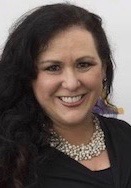Daily Business Report-Jan. 18, 2019
Edhuar Arellano has been driving for Uber and Lyft for four years. He says the companies should make drivers employees. (Photo courtesy of Edhuar Arellano)
Fight over the future of work moving
front and center in state Legislature
By Dan Morain | CALmatters

Legislators last year punted on grappling with the California Supreme Court ruling that requires companies such as Uber and TaskRabbit to count gig workers as full employees, rather than independent contractors.
Not this year.
Democratic Assemblywoman Lorena Gonzalez Fletcher of San Diego made certain the issue is front and center by introducing Assembly Bill 5. The bill would put into statute last April’s ruling in Dynamex Operations West Inc. For CALmatters’ primmer on the issue, click here.
Here’s what to expect:
• In the coming weeks, Gonzalez Fletcher, who is close to organized labor, will add details to her bill.
• Business groups led by the California Chamber of Commerce will push one or more bills to soften the impact of the ruling.
• The ruling’s scope is breathtaking. It could be applied to emergency room physicians, health care workers such as dieticians, barbers, insurance agents and many more professions. Expect many of them to be carved out in legislation that leaves their status relatively unchanged.
Labor lobbyists are seeking worker protections:
• Workers’ compensation in case they are hurt on the job.
• Guaranteed minimum wage.
• Unemployment benefits.
Gonzalez Fletcher sees the issue as basic to “rebuilding middle class.” If companies for which gig workers work don’t provide basic protections, the cost of, say, health care for an injured worker falls to taxpayers, the Assemblywoman said. “You can have flexibility. But we have to have have rules,” said Fletcher.
No issue matters more to business and labor than how to compensate and protect people who work in the gig economy.
Gov. Gavin Newsom said it’s among the topics he must address: “You will be hearing a lot more in the coming days.
The gig economy is expected to grow from $14 billion in 2014 to $335 billion in 2025.
___________________

Does the gig economy
exploit independent contractors?
By Suzanne Finch | SDSU NewsCenter
The economic meltdown of 2008 led to an explosion of workers participating in the gig (“sharing”) economy by using their skills or personal resources to create an income source. A San Diego State University researcher has found that companies who contract with these workers often exploit them in terms of salary and excess scrutiny relative to their traditionally employed counterparts.
Research by Mujtaba Ahsan, management professor from the Fowler College of Business, examined the challenges faced by private contractors and the ethical behavior of the companies who utilize their labor.
Ahsan found the gig economy is expected to grow from $14 billion in 2014 to $335 billion in 2025, and the number of gig workers in the United States is expected to reach 9.2 million by 2021. He also noted gig workers generally fall into four categories: freelancers who have chosen to work gigs as their primary source of income (32 percent); casual earners who willingly use gigs to supplement their primary incomes (40 percent); reluctants who are unable to find traditional work and are forced to rely on gigs as their primary income (14 percent); and the financially strapped who work gigs to supplement other income sources (14 percent).
Companies such as TaskRabbit, Fiverr, Postmates and Uber, who hire many of these workers, call them “partners” or “micro-entrepreneurs” and emphasize the fact that they can set their own hours and work as much or as little as they choose.
Ahsan’s research found evidence of exploitation in this practice, particularly in the case of Uber.
“Drivers might be free to show up for work or leave at a time of their choosing, but once they report for duty, their actions are scrutinized, monitored, tabulated and controlled with great precision,” he said. “Decisions are set by an app controlled by Uber, which determines performance metrics, monitors the number of rides accepted or cancelled, and sets pay. Very little is left up to the driver.”
Ahsan also noted that drivers are required to maintain a customer rating of 4.6 stars out of a possible rating of 5 stars.
A survey released in 2018 by the Economic Policy Institute indicates 90 percent of all wage and salary workers earn more than Uber drivers,” Ahsan said.
“The income Uber drivers earn after deducting Uber fees and vehicle expenses is only $11.77 per hour, approximately 65 percent less than the hourly compensation of private-sector workers and 20 percent less than the hourly compensation in the lowest-paid major occupations.”
Ahsan said there is evidence to suggest that the rise of the gig economy could increase income inequalities as company founders and investors are appropriating more “value” at the expense of independent contractors carrying out the required labor.
“The challenge now for entrepreneurship scholars is to better understand how certain entrepreneurial behaviors further income inequities and to develop programs and shape policies that encourage entrepreneurial behaviors that go beyond self-interest to promote societal benefits.”
___________________
Hera Hub announces Benefit Corporation status

Hera Hub, the international, female-focused coworking space, announced that it is now an official Benefit Corporation. Benefit Corporations are committed to higher standards of accountability, transparency and social impact.
Benefit corporation legislation creates the legal framework to enable mission-driven companies to stay mission-driven through succession, capital raises, and even changes in ownership, by institutionalizing the values, culture, processes, and high standards put in place by founding entrepreneurs.
Since it’s inception, Hera Hub has served as both a resource and built-in community for women-owned business.
Hera Hub Founder Felena Hanson said she is excited about this step for Hera Hub claiming transparency, accountability and commitment to ensuring sustainable social and environmental impact. “Hera Hub has always been focused on making a positive impact on the community. We do this in three ways – programs to help people get back into the workforce, donation of space to non-profit organizations, and free business education and mentoring programming. Becoming a Benefit Corporation is simply a way for us to better articulate the impact we’ve made over the last seven years and the impact we hope to make in the future,” said Hanson.
___________________
Dr. Megan Hamreus elected chief of staff
at 2 Scripps Mercy Hospital campuses

The physicians of Scripps Mercy Hospital’s San Diego and Chula Vista campuses have elected hospitalist Megan Hamreus as the chief of staff. Hamreus took over as head of the 1,100-member physician team on Jan. 1.
As chief of staff for Scripps Mercy Hospital’s two campuses, Hamreus will serve as a medical staff liaison to Scripps Mercy San Diego’s administrative staff and Scripps Health’s board of trustees. During her two-year term, she will play a key role in driving continuous improvement in the delivery of health care services to the more than 200,000 patients who visit the hospital annually. She succeeds the hospital’s outgoing chief of staff, Michael Sise, M.D.
Hamreus has been a member of the medical staff at Scripps Mercy Hospital for 10 years, and earlier was on the medical staff at Scripps Memorial Hospital La Jolla. Previously, she served as a hospitalist at various hospitals throughout California. Hospitalists are physicians whose primary professional focus is the general medical care of hospitalized patients. Their activities include patient care, teaching, research and leadership related to hospital medicine.
___________________
Personnel Announcements
David Naranjo joins STM Brands
STM Brands, a leader in the creation and production of innovative bags, cases, and accessories for consumer electronic devices, announces the addition of David Naranjo as vice president of product design and development. STM Brands is the parent company of two global brands: STM Goods (backpacks, briefs, and cases for digital gear) and Element Case (premium cases for wireless phones).
Naranjo brings a wealth of experience, knowledge, and success in product design, development, management, and leadership to his role at STM Brands. Prior to joining STM Brands, he served as director of product planning at Samsung, orchestrating business development and product planning for various products and technologies for the enterprise and consumer industries.
Before Samsung, Naranjo held high-level roles in general management, product development, and product management for widely recognized companies such as Kenmore, Panasonic, Mitsubishi, and General Instruments/Motorola. Naranjo has a bachelor’s degree in electrical engineering and an MBA in marketing and finance.
Democrat Assemblywoman Buffy Wicks, left, plays with her two-year-old daughter after being sworn in. (Photo by Max Whittaker for CALmatters)
___________________
Progressive leader?
When it comes to female lawmakers,
California ties Georgia for 20th place
By Elizabeth Castillo, CALmatters
With the 2018 election hailed as the Year of the Woman, how far has California—a state that prides itself on being on the progressive vanguard—actually come?
As CALmatters’ latest “Legislators: Just Like You?” interactive demonstrates, only three out every ten lawmakers are now women. That means not only is California far behind neighboring Nevada, which became the first state with a majority of female legislators. It lags 19 states, including its other regional neighbors Arizona, Oregon and Washington, not to mention New York and Colorado, according to the latest count by the National Conference of State Legislatures. This is true despite the fact that California reached a high-water mark in the last election for the largest number of women elected to state and federal office this century.
Notably, California is represented by powerful women in Washington D.C., including both U.S. senators and the House Speaker, as well as its first female lieutenant governor, Eleni Kounalakis, and Senate President Pro Tem Toni Atkins. It has never, however, come close to accurately reflecting the majority of adult Californians who are female, and has never elected a female governor.
Why the gap? Political scientists have noted that women sometimes face a double-standard of judgment even from female voters, and that women typically face more obstacles raising campaign cash. But there’s another potential barrier that deters women from running and winning elected office—the need for child care. And a bill introduced by Democratic Assemblyman Rob Bonta of Alameda aims to lessen that barrier.
Even Bonta, when first ran for Assembly, found that a lack of child care impacted him. “I had to miss meetings,” he said. “I had to miss important campaign events.”
Assemblywoman Blanca Rubio recalled traveling to events where her departing flight left at 7 a.m. and her her returning flight at 9 p.m. She even filled in 16 different names on her children’s emergency contact forms so that a vast cadre of family and friends were authorized to pick up her kids when she was on the campaign trail.
While the law now allows candidates to spend a max of $200 per event on child care, according to the California Fair Political Practices Commission’s campaign manual, Bonta’s bill would eliminate that cap.
The manual currently doesn’t specify what constitutes an event, or whether parents may spend money on child care when they have flight schedules that conflict with their children’s school schedule? Bonta said the bill will create clarity.
Childcare has proven a challenge for many female candidates—among them Oakland’s new Democratic Assemblywoman Buffy Wicks, who has acknowledged the complications of breastfeeding her child while running for office.
“The thing that I realize is, sometimes in order to fight for change you need a little help changing the diaper.”
Parents of young children are part of this year’s class of new lawmakers. So while the number of female lawmakers still doesn’t match the number of men, the update in campaign finance rules could be one way to close that gap.
“The simple truth is that women are underrepresented at every level of government—from city councils to state Assembly to Congress,” said the bill’s co-author Democratic Assemblywoman Cottie Petrie-Norris of Laguna Beach, in a press release. “This bill removes a critical barrier and helps more women run for office and enter public service.”
Note: This comparison is based on CALmatters’ calculation of the percentage of California’s female legislators, which at 30.5 percent ranks California slightly higher for gender equity than the 29.2 percentage used by the National Conference of State Legislatures. Our percentage is based on a total of 118 California legislators instead of 120, because two seats are currently vacant and will be filled by upcoming special elections.
CALmatters.org is a nonprofit, nonpartisan media venture explaining California policies and politics.




